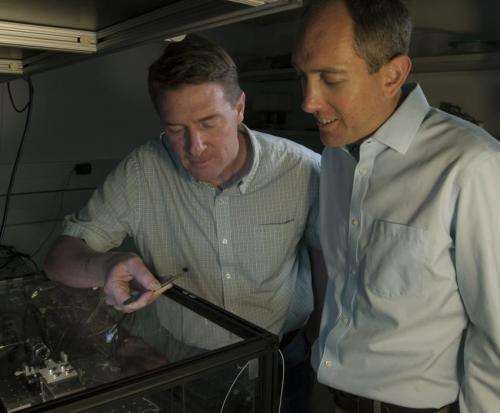'Comb on a chip' powers new atomic clock design

Researchers from the National Institute of Standards and Technology (NIST) and California Institute of Technology (Caltech) have demonstrated a new design for an atomic clock that is based on a chip-scale frequency comb, or a microcomb.
The microcomb clock, featured on the cover of the inaugural issue of the new journal Optica, is the first demonstration of all-optical control of the microcomb, and its accurate conversion of optical frequencies to lower microwave frequencies. (Optical frequencies are too high to count;microwave frequencies can be counted with electronics.)
The new clock architecture might eventually be used to make portable tools for calibrating frequencies of advanced telecommunications systems or providing microwave signals to boost stability and resolution in radar, navigation and scientific instruments. The technology also has potential to combine good timekeeping precision with very small size. The comb clock might be a component of future "NIST on a chip" technologies offering multiple measurement methods and standards in a portable form.
"The microcomb clock is one way we might get precision frequency metrology tools out of the lab and into real-world settings," NIST physicist Scott Diddams says.
Frequency combs produce precisely defined colors, or frequencies, of light that are evenly spaced throughout the comb's range. (The name comes from the spectrum's resemblance to the teeth of a pocket comb.) The original combs required relatively large lasers that produced rapid, extremely short pulses of light, but more recently NIST and other laboratories have developed much smaller microcombs.
A microcomb generates its set of frequencies from light that gets trapped in the periphery of a tiny silica glass disk, looping around and around the perimeter. These combs can be astonishingly stable. NIST has an ongoing collaboration in this area with Caltech researchers, who made the 2-millimeter-wide silica disk that generates the frequency comb for the new clock.
The new microcomb clock uses a laser to excite the Caltech disk to generate a frequency comb, broadens the spectrum using nonlinear fiber, and stabilizes two comb teeth (individual frequencies) to energy transitions in rubidium atoms that "tick" at optical frequencies. (Conventional rubidium atomic clocks operate at much lower microwave frequencies.) The comb converts these optical frequency ticks to the microwave domain.
Thanks to the gear-like properties of the disk and the comb, the output is also 100 times more stable than the intrinsic ticking of the rubidium atoms. According to Diddams. "A simple analogy is that of a mechanical clock: The rubidium atoms provide stable oscillations—a pendulum—and the microcomb is like a set of gears that synthesizes optical and microwave frequencies."
The center of the comb spectrum is locked to an infrared laser operating at 1560 nanometers, a wavelength used in telecommunications.
NIST researchers have not yet systematically analyzed the microcomb clock's precision. The prototype uses a tabletop-sized rubidium reference. The scientists expect to reduce the instrument size by switching to a miniature container of atoms like that used in NIST's original chip-scale atomic clock. Scientists also hope to find a more stable atomic reference.
The microcomb chip was made by use of conventional semiconductor fabrication techniques and, therefore, could be mass produced and integrated with other chip-scale components such as lasers and atomic references. NIST researchers expect that, with further research, the microcomb clock architecture can achieve substantially better performance in the future.
More information: S.B. Papp, K. Beha, P. Del'haye, F. Quinlan, H. Lee, K.J. Vahala and S.A. Diddams. A microresonator frequency comb optical clock. Optica 1, 10-14. July 22, 2014.
Provided by National Institute of Standards and Technology




















